Newsletters
- Home
- Publications
- Newsletter Archive
- Newsletter
September/October 2018
Inside This Issue:
- Research Explores Employment Opportunities for People with Intellectual, Developmental Disabilities
- State of Addiction Public Hearing Held in Cambria County
- Chairman's Message
- Center Board Welcomes New Member
- Rural Snapshot: Suicides in Pennsylvania
- Homeownership Report Released in August
- Just the Facts: Born in PA, Live in PA
Research Explores Employment Opportunities for People with Intellectual, Developmental Disabilities
Pennsylvania’s Employment First Act, signed into law in June 2018, requires some important changes in employment supports for people with disabilities. It requires state, county, and other entities receiving public funds to first consider competitive integrated employment for individuals with a disability who are eligible to work under state law.
The results of recent research conducted by faculty of Indiana University of Pennsylvania and sponsored by the Center for Rural Pennsylvania could offer important information to state agencies that are working to implement the provisions of Employment First.
The research, conducted in 2017 and 2018 by Dr. Susan Boser, Dr. Brandon Vick, Dr. Alex Heckert, and Dr. David Yerger, identified the opportunities for competitive employment for individuals with a disability; analyzed the barriers for obtaining such employment, with a focus on rural barriers; and identified the strategies other states are using successfully. The research used secondary data from the U.S. Department of Labor and the Census Bureau. The researchers surveyed service providers, conducted focus groups with families of individuals with disabilities and with service providers, and interviewed individuals representing various stakeholder groups at the regional, state and national levels.
Research results
The surveys of sheltered workshops and subminimum wage program providers identified 26 work activities that can be done by subminimum wage workers with support. From this information, the researchers identified 95 occupations as being potential matches for subminimum wage workers, including laborers/movers, retail salespersons, and nursing/home health aides. The results from the quantitative analysis point to a number of employment barriers in the 95 identified occupations for which subminimum wage workers are likely to compete, including higher levels of competition in rural areas, higher susceptibility to automation, lower pay, and lower expected job growth.
The qualitative analysis uncovered a number of time and benefit gaps that may delay employment. These include the time it takes to access job-related supports when moving to employment and the reinstatement of benefits when coming out of employment. The length of such gaps and the complicated processes related to benefits and employment serve as a disincentive for families, many of whom support the idea of competitive, integrated employment in principle, but feel that the potential risks are too high to pursue.
The research identified three additional barriers. First was the transportation system available for persons with disabilities in rural areas. These systems are designed for congregate care settings, and currently are not able to accommodate the needs of individuals seeking competitive, community-based employment. Second, the structure of the rate system for providers is not well-aligned to support competitive employment goals, particularly the rates to hire, train and maintain professional staff in the necessary employment and benefits services. Third, state agencies maintain separate data management systems that do not permit cross-system access to data, system queries, and data management integration. Each limitation inhibits access to information on program effectiveness and the ability to monitor outcomes.
The researchers offer several policy considerations including: increasing the flexibility of regulations; aligning funding rates with the goals of employment, and ensuring that provider agencies receive adequate funding for professional staff with the appropriate training; developing a transportation system, similar to the system created for medical appointments, to meet the flexible transportation needs for community-based employment; and setting employment goals for employment rates of individuals with disabilities that reflect the variations in the availability of jobs and the competition for those jobs in rural areas.
Report available
Click here for a copy of the report, Employment Opportunities for Rural Residents with Disabilities in Pennsylvania.
State of Addiction Public Hearing Held in Cambria County
To gather more information on medication assisted treatment services, county drug courts, and reemployment opportunities for people battling addiction to heroin and opioids, the Center for Rural Pennsylvania held a public hearing in Ebensburg on August 15.
“From our previous hearings, the Center learned how difficult it is for people with a substance use disorder to get back to work,” said Senator Gene Yaw, board chairman. “We also heard about the many treatment options for individuals that can help them in recovery. At this hearing, we wanted to learn more about the local programs that help with reemployment, the success of county drug courts, and the treatment programs that help people recover from their addiction and be successful in their recovery.”
Center Board Members Dr. Nancy Falvo, Dr. Michael Driscoll, and Darrin Youker, along with Barry Denk, Center director, presided over the hearing. State Senator Wayne Langerholc hosted the hearing, which was also attended by Senator John Eichelberger and Representative Frank Burns.
Presenters were Tracy Selak, Cambria County Human Services Administrator; Cambria County Assistant District Attorney Arnold Bernard Jr.; Kate Porter, Cambria County Drug Coalition Prevention Program Specialist/Communities that Care Mobilizer; Amanda Cope, Chief Operating Officer at Positive Recovery Solutions; Luzerne County Assistant District Attorney and Immediate Past President of the Pennsylvania Association of Drug Court Professionals James McMonagle; Susan Whisler, Director of Workforce Development at Southern Alleghenies Planning and Development Commission; Ronald Aldom, Executive Director of Somerset County Chamber of Commerce; Jeffrey Dick, Site Administrator at the Pennsylvania Department of Labor & Industry’s Bureau of Workforce Partnership and Operations; and Brooke McKenzie, Director of the Twin Lakes Center and Hospice. To read the testimony presented and watch a video of the hearing, click here.

Pictured left to right are Cambria County Drug Coalition members Kate Porter, Prevention Program Specialist/Communities that Care Mobilizer;
Tracy Selak, Cambria Co. Acting Drug and Alcohol Program Administrator; and Arnold Bernard, Jr., Cambria Co. Assistant DA.
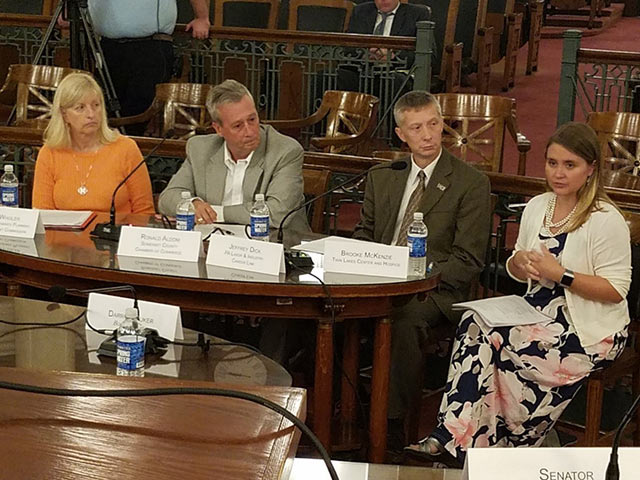
Pictured from left: Susan Whisler, Ronald Aldom, Jeffrey Dick, and Brooke McKenzie.
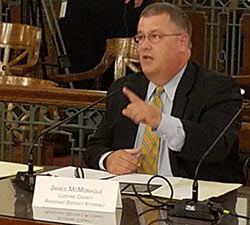 James McMonagle |
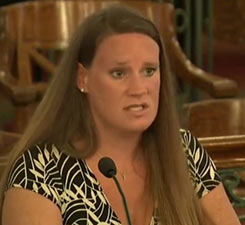 Amanda Cope |
Chairman's Message
In August, the Center’s board held its 14th public hearing on the heroin/opioid epidemic to learn more about medication assisted treatment options, the work of county drug treatment courts, and county-wide efforts to support reemployment of people in recovery.
Each of our hearings has helped us to better understand a host of issues that not only affect people battling addiction but also families, communities, law enforcement, social services, the judiciary, health care, our workforce, and so much more.
This latest hearing helped to reinforce the importance of medication assisted treatment options, with medications like vivitrol, and the significant work of county drug treatment courts to help people with addiction get back on track in their home and work lives while continuing to work on their recovery. We also heard about the critical work of Single County Authorities, engaged community members, law enforcement, state agencies and the treatment community in developing wrap-around services and reemployment options that can help people work toward recovery and overcome barriers to housing and employment. We know there is no single solution out there that is going to solve this crisis, and, as we’ve seen over the past four years, we must continue to attack the crisis from every angle.
On behalf of the Center’s board, I thank Sen. Wayne Langerholc for sponsoring this latest hearing in Ebensburg, and I thank Sen. John Eichelberger and Rep. Frank Burns for joining us. A link to the hearing video is on the Center’s website.
On behalf of the Center’s board, I also thank Dr. Livingston Alexander of the University of Pittsburgh-Bradford for his service to the board. Dr. Alexander retired as president of Pitt-Bradford and from his position on our board this past summer. Dr. Alexander joined the board in August 2010, and since then he has provided great insight and feedback to the Center about our rural communities, which has helped the Center to develop a research agenda that continues to yield timely and important policy considerations for the General Assembly. We wish Dr. Alexander all the best in his retirement.
Senator Gene Yaw

Center Board members and area legislators at the State of Addiction public hearing at the Cambria County Courthouse in Ebensburg, PA.
Center Board Welcomes New Member
 In July, the Center for Rural Pennsylvania’s Board of Directors welcomed Dr. Lawrence Feick, who represents the University of Pittsburgh, to the board. Dr. Feick is Interim President of the University of Pittsburgh at Bradford and the University of Pittsburgh at Titusville, and is currently on leave as Vice Provost for Special Projects at the University of Pittsburgh. From 2007 to 2015, he served as the Senior Director of International Programs and the Director of the University Center for International Studies at the University of Pittsburgh. He is Professor of Business Administration at the Joseph M. Katz Graduate School of Business at Pitt, where he has been a faculty member since1982. From 1999 through 2005 he served as the Director of the University’s International Business Center. Previously, Dr. Feick served on the faculty at Pennsylvania State University where he earned his Ph.D. Dr. Feick teaches in the areas of marketing management and international marketing. He is the coauthor of Country Manager, an international marketing simulation game and has been a visiting professor at the University of Augsburg (Germany), Czech Management Center (Czech Republic), International Management Center (Hungary), Comenius University (Slovak Republic), Universidad Santa Maria (Ecuador), and the University of Montevideo (Uruguay), where he was a Fulbright Senior Specialist.
In July, the Center for Rural Pennsylvania’s Board of Directors welcomed Dr. Lawrence Feick, who represents the University of Pittsburgh, to the board. Dr. Feick is Interim President of the University of Pittsburgh at Bradford and the University of Pittsburgh at Titusville, and is currently on leave as Vice Provost for Special Projects at the University of Pittsburgh. From 2007 to 2015, he served as the Senior Director of International Programs and the Director of the University Center for International Studies at the University of Pittsburgh. He is Professor of Business Administration at the Joseph M. Katz Graduate School of Business at Pitt, where he has been a faculty member since1982. From 1999 through 2005 he served as the Director of the University’s International Business Center. Previously, Dr. Feick served on the faculty at Pennsylvania State University where he earned his Ph.D. Dr. Feick teaches in the areas of marketing management and international marketing. He is the coauthor of Country Manager, an international marketing simulation game and has been a visiting professor at the University of Augsburg (Germany), Czech Management Center (Czech Republic), International Management Center (Hungary), Comenius University (Slovak Republic), Universidad Santa Maria (Ecuador), and the University of Montevideo (Uruguay), where he was a Fulbright Senior Specialist.
Rural Snapshot: Suicides in Pennsylvania
Note: The data source for this Rural Snapshot is the Pennsylvania Department of Health, unless noted otherwise.
Suicide Rates by County, 2014-2016
(Number of Suicides per 100,000 Residents)
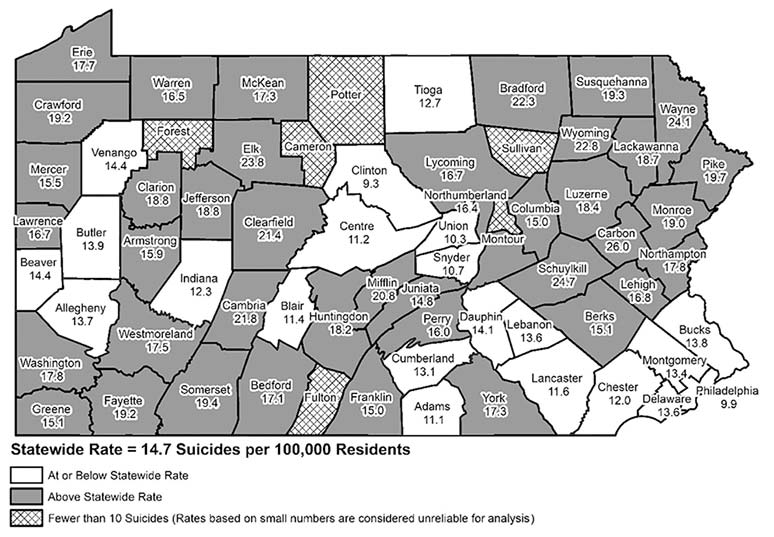
Number of Rural and Urban Pennsylvania Suicide Deaths by Age, 2016

Rural and Urban Pennsylvania Suicides by Gender, 2016
In rural Pennsylvania, 82 percent of suicide deaths were male and 18 percent were female.
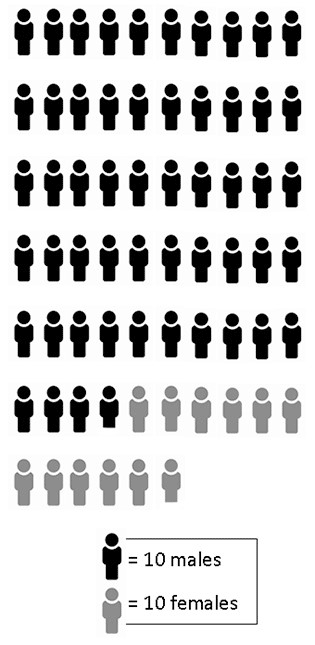
Total male = 538
Total female = 119
- In 2016, 59 percent of rural suicide deaths were by firearm. From 2006 to 2016, rural suicide deaths by firearm increased 52 percent.
- In 2016, 45 percent of urban suicide deaths were by firearm. From 2006 to 2016, urban suicide deaths by firearm increased 23 percent.
Rural and Urban Pennsylvania Suicide Rates per Capita, 1990 to 2016
(Number of Suicides per 100,000 Residents)
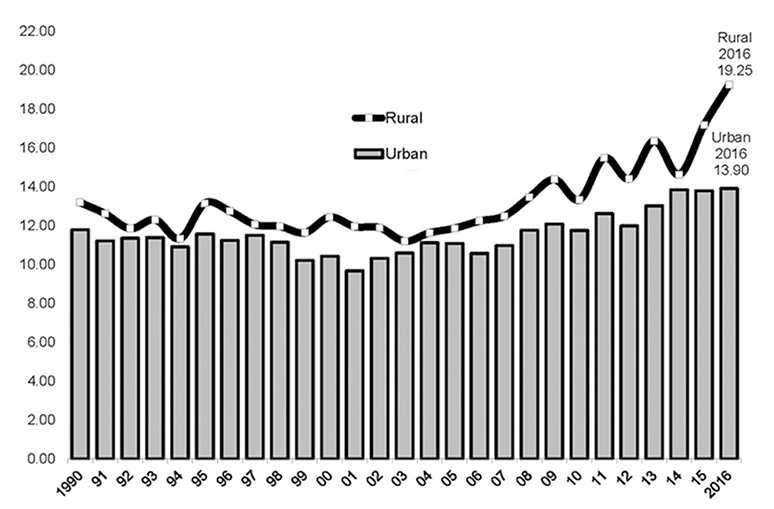
Rural and Urban PA Resident €œYes€ Responses to Mental Health Questions on the 2014-2016 Behavioral Risk Factor Surveillance System Survey
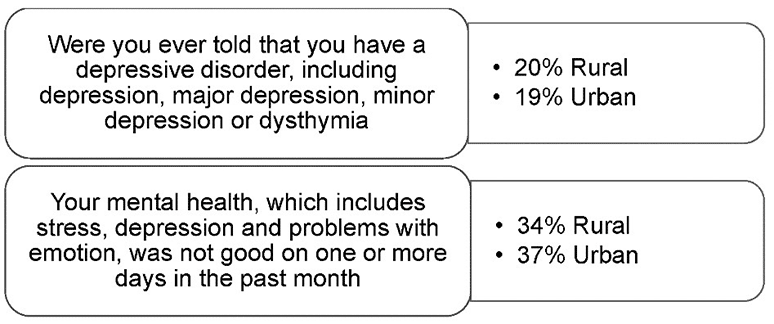
Mental Health Care Providers in Rural and Urban Pennsylvania, 2018*
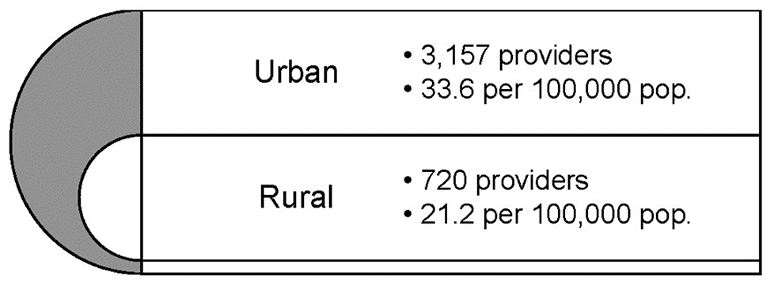
*Mental health care providers include psychiatrists, neuropsychiatrists, clinical psychologists, clinical social workers, and geriatric psychiatrists. Data include only those providers who accept Medicare approved amounts as payment in full or professionals that accept Medicare Assignment. Data source: Centers for Medicare & Medicaid Services.
Homeownership Report Released in August
In August, the Center released the research report, Changes in Homeownership in Pennsylvania’s Rural Municipalities. The research, conducted by Dr. Kristen B. Crossney of West Chester University, examined homeownership rates in rural Pennsylvania municipalities from 2000 to 2015.
The research indicated that Pennsylvania, as a whole, experienced a decline of about 2 percentage points in homeownership rates and an increase of about 1 percent in the number of homeownership units from 2000 to 2015. Overall, rural Pennsylvania municipalities experienced a decline of about 1 percentage point in homeownership rates, and an increase of about 3 percent in homeownership units during the same time period. The increase in units occurred in rural townships, which experienced an increase of about 4 percent in the number of homeownership units; rural cities and boroughs experienced a decrease of almost 6 percent in the number of homeownership units.
The research indicated that rural townships have higher homeownership rates than rural cities and boroughs, and that rural cities and boroughs have higher rates than their urban counterparts.
Click here for a copy of the report.
Just the Facts: Born in PA, Live in PA
Pennsylvanians must love their home state since most residents were born here. According to Census Bureau data, 77 percent of rural Pennsylvanians were born in the commonwealth and 23 percent were born out-of-state. Among urban Pennsylvanians, 72 percent were born in Pennsylvania and 28 percent were born out-of-state.
Compared to other states, Pennsylvania has the nation’s fourth highest percentage of residents living in the same state in which they were born. The three states with higher percentages of residents living in the same state in which they were born are Louisiana (78 percent), Michigan (77 percent), and Ohio (74 percent). The three states with the lowest percentages of residents living in the same state in which they were born are Arizona, Florida, and Nevada, each with less than 40 percent.
Are there any differences between rural residents born and living in Pennsylvania and rural residents born out-of-state and now living in Pennsylvania? To find out, the Center analyzed data from the Census Bureau’s 2016 American Community Survey, Public Use Microdata Sample. Here are the results:
- Age: Residents born in Pennsylvania are, on average, slightly younger (41.3 years old) than those born out-of-state (43.2 years old).
- Income: The median wage for Pennsylvania-born residents who work full-time, year-round was $41,311. For those full-time, year-round Pennsylvania workers who were born out-of-state, the median wage was $45,341($4,000 more).
- Race: 4 percent of residents who were born in Pennsylvania are non-white, and 17 percent of residents who were born out-of-state are non-white.
- Educational attainment: 16 percent of adult residents (18+ years old) who were born in Pennsylvania have a bachelor’s degree or higher and 25 percent of adult residents who were born out-of-state have a bachelor’s degree or higher.
There were a number of similarities among rural residents who were born in Pennsylvania and rural residents born out-of-state. They are:
- Marriage: 52 percent of adults born in Pennsylvania and 53 percent of adults born out-of-state are married.
- Labor force participation: 59 percent of each (residents born in and out-of-state) are working.
- Poverty: 12.5 percent and 12.4 percent are the poverty rates for those born in Pennsylvania and out-of-state, respectively.
- Self-Employment: 8 percent of each (residents born in Pennsylvania and residents born out-of-state) are self-employed.
